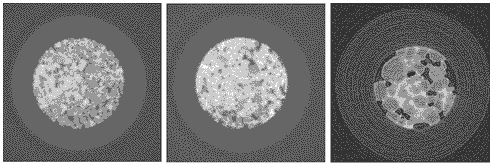A common problem in understanding unsaturated flow processes is the lack of information about the porous medium through which the water is flowing and the pore-scale processes governing water flow and transport. In recent years, researchers in soil science, water resources, and the petroleum industry have increased their interest in techniques that aid this understanding, including network and Lattice-Boltzmann modeling as a way to better understand unsaturated flow processes.
This increased interest is also motivated by growing evidence that the techniques used to measure hydraulic properties can have a significant impact on the experimental results. In particular, a dependence on drainage flow rate has been observed, suggesting interference from dynamic phenomena such as air entrapment, pore-water blockage, influence of flow velocity on the solid-liquid-gas contact angle, etc. Generally, more water is retained at a given capillary pressure for dynamic drainage than for static equilibrium and steady-state cases. As many researchers now use new, faster methods to determine the hydraulic characteristics of porous materials, it is important to examine the influence of boundary conditions on the measurement results for these experiments. These mechanisms, operating at the microscale, cannot be measured with traditional techniques, which generally require insertion of a sensor at or near the region of interest.
X-ray computed microtomography (CMT) overcomes this problem. CMT is a synchrotron x-ray technique for determining the internal structure of an object. It uses projection views (radiographs) from different angles to mathematically reconstruct the complete three-dimensional image of the object. The physical basis for the technique is the absorption or attenuation of the penetrating electromagnetic radiation by the object. The attenuation depends on the density and the atomic constituents of the material that is scanned and the transmitted radiation is compared to the incident radiation to reconstruct a map of attenuation coefficients versus position in the object
Using the GeoSoilEnviroCARS Collaborative Access Team CMT instrument at Advanced Photon Source sector 13, cylindrical samples of sand-packs (6 mm and 1.5 mm inside diameter) were scanned during drainage. Two different types of experiments were performed on the samples: (1) one-step experiments where drainage was induced with one relatively high air-phase pressure and (2) multi-step experiments where a varying number of smaller pressure increments were applied. Spatial and temporal changes in water saturation can then be compared for cases where different fluid flow rates apply. The results can be seen in the figures above.
CMT offers the possibility of non-invasively investigating dynamic flow and transport processes on the pore scale and the opportunity to quantitatively explain the observed flow-rate dependent phenomena. Moreover, it is expected that the high spatial resolution measurements will provide a unique database that can be used for verification of Lattice Boltzmann simulations or network modeling of flow and transport in unsaturated porous media.
D. Wildenschild, Lawrence Livermore National Laboratory, USA1
J.W. Hopmans, University of California Davis, USA
C.M.P. Vaz, Embrapa CMPDIA, Sao Carlos, Brazil
M.L. Rivers, Consortium for Advanced Radiation Sources, University of Chicago, USA
1Currently at Dept. of Hydrodynamics and Water Resources, Technical University of Denmark, Lyngby, Denmark.
Work supported in part by IGPP Grant 00-GS-012 and by the Environmental Management Science Program of the DOE Office of Science under contract No. W-7405-ENG-48. Use of the Advanced Photon Source was supported by the DOE Basic Energy Sciences, Office of Science, under Contract No. W-31-109-ENG-38.

